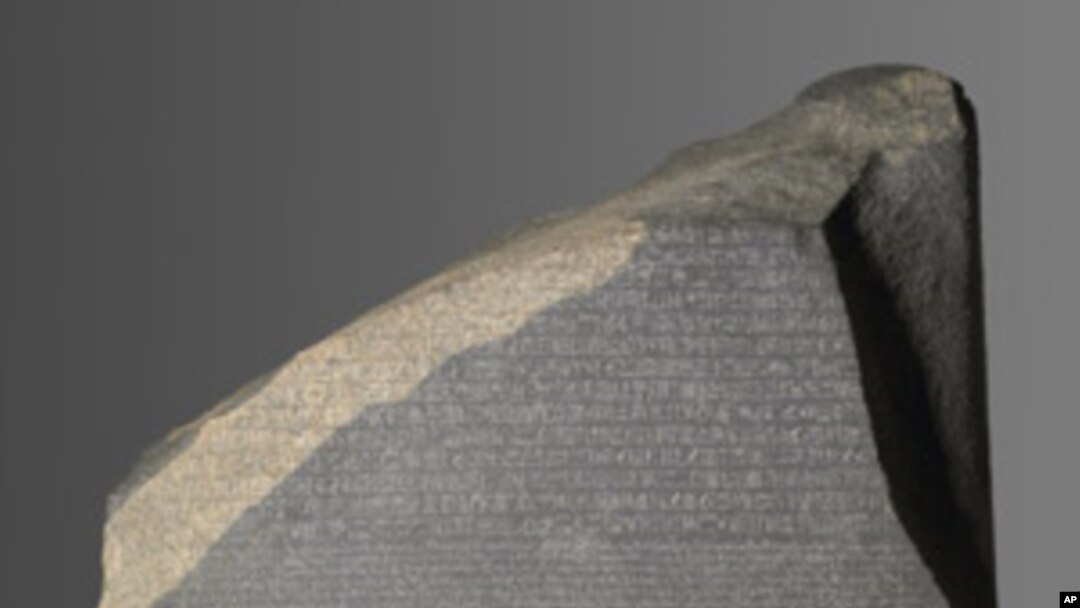The head of Egypt's Supreme Council of Antiquities, Zahi Hawass, wrapped up a two-day conference in Cairo for nations seeking the return of their valuable antiquities and artifacts. Hawass has made it his mission to track down Egyptian antiquities he believes were wrongly removed from Egypt and to bring them home.
While in Washington last month, Hawass beamed with pride when he accepted the return of an apparently smuggled ancient Egyptian coffin that a U.S. customs agent had intercepted at Miami airport.
"People can think that the best moment in the life of an archaeologist is actually to discover something," Hawass said. "But for me, the best thing is to return something to Egypt."
If that is the case, Hawass has experienced many best moments. By his count, he has overseen the return of 31,000 objects since 2002. Such artifacts are intercepted as they are illicitly smuggled across borders; some are identified as they are readied for the auction block; some are retrieved from the halls and walls of world-renowned museums.
Last year, France repatriated the last of five 3,000-year-old stolen Egyptian relics that ended up in the French Louvre museum. They were removed from a wall painting of an ancient Egyptian tomb in the 1980s.
To Hawass, each return is a victory, not just for Egypt, but for all mankind.
"This is not our heritage," he said. "It is the heritage of the human being all over the world."
| Video: Tess Davis, Executive Director of the Lawyers' Committee for Cultural Heritage Preservation, explains some key terms and concepts |
|---|
| What is "stolen art"? (:24) |
| Are there legal guidelines in place? (:26) |
| Do people or countries ever get artwork returned? (:45) |
| What is "provenance"? (:24) |
| Is there a compromise? (:24) |
| What is "repatriation"? (1:18) |
| What about cultural looting? (:17) |
Ironically, that is the same argument made by those in the art world who oppose the idea of taking artifacts out of international museums and returning them to their places of origin.
"We all own antiquity or have responsibility for stewarding the past into the future," said Art Institute of Chicago Director James Cuno, author of the book "Who Owns Antiquity?”
Cuno agrees with Hawass that antiquity belongs to all human kind.
"This is a joint responsibility. It is not the responsibility of a single nation state," said Cuno.
Egypt is not alone in this pursuit of artifacts; from Nigeria to Greece to Peru, nations are demanding the repatriation of cultural works.
But that is not simple, says lawyer Tess Davis, the assistant director of Heritage Watch and executive director of the Lawyers' Committee for Cultural Heritage Preservation.
"You have a museum that says, 'I purchased this. I paid good money for this. I am the rightful owner.' You have a country that says, 'this antiquity, this piece of art, this comes from our country. We are the rightful owner,'" explained Davis.
Take the case of the Parthenon Sculptures, more commonly known as the Elgin Marbles. The elaborate marble carvings adorned the Parthenon temple in Athens for more than 2,000 years.
By 1800, the Parthenon was in a state of ruin. Around that time, Britain's Ambassador to the Ottoman Empire, Thomas Bruce, the Earl of Elgin, asked Athen's Ottoman occupiers for permission to take some of the sculptures.
They have been displayed at the British Museum in London for nearly 200 years. Last year, more than five million people visited the international museum. But the Greek government wants the marbles to be reunited with other Parthenon Sculptures at a new Acropolis museum in Athens.
Davis acknowledges it is a tricky issue.
"I think, morally, a lot of people would think the Elgin Marbles are the property of Greece, but legally, most people agree that they are the property of England," Davis explained.
Cuno argues there is really no basis to decide if a nation has a compelling moral case. He says decisions about repatriation should come down to whether a law has been broken.
"Otherwise it is a matter of going back and rewriting history," he contended.
Cuno points out modern-day Greece was not formed until decades after the sculptures were removed. He says the present focus on Athenian culture is at the expense of other cultures that hold ties to Greek history.
"That forces us to look upon the past in ways that are not true to the past," he said. "It is putting territorialized identities on the past when the past did not have those identities."
Cuno says there is an added value in seeing works of shared cultural heritage in an international museum, where the viewer can understand the world is diverse and has forever been in contact with itself.
"When you are at a museum like the British Museum and you are looking at the Parthenon marbles, you can recall from neighboring galleries the visual effect of Egyptian sculpture or of subsequent Roman sculpture or of contemporaneous Chinese sculpture," he explained.
Davis says there is a difference between theory and practice when it comes to this idea of the so-called "universal museum."
"If we are ever going to make that idea true, then we need to make sure someone in Phnom Penh, Cambodia, can go into a museum and see examples of American and French and Japanese art, which is not the case," underscored Davis. "It has been a very one-sided path up to now."
Davis and Cuno agree that loans of artifacts and antiquities are a prime way for people throughout the world, and not just those in Western capitals, to enjoy and be inspired by the cultural works.
And for those who fear that by returning one iconic item museums could open themselves up to forfeiting their antiquities collections, Davis points out New York's Metropolitan Museum of Art has repatriated objects, and its 600,000 square-meter building remains full of priceless treasures.


